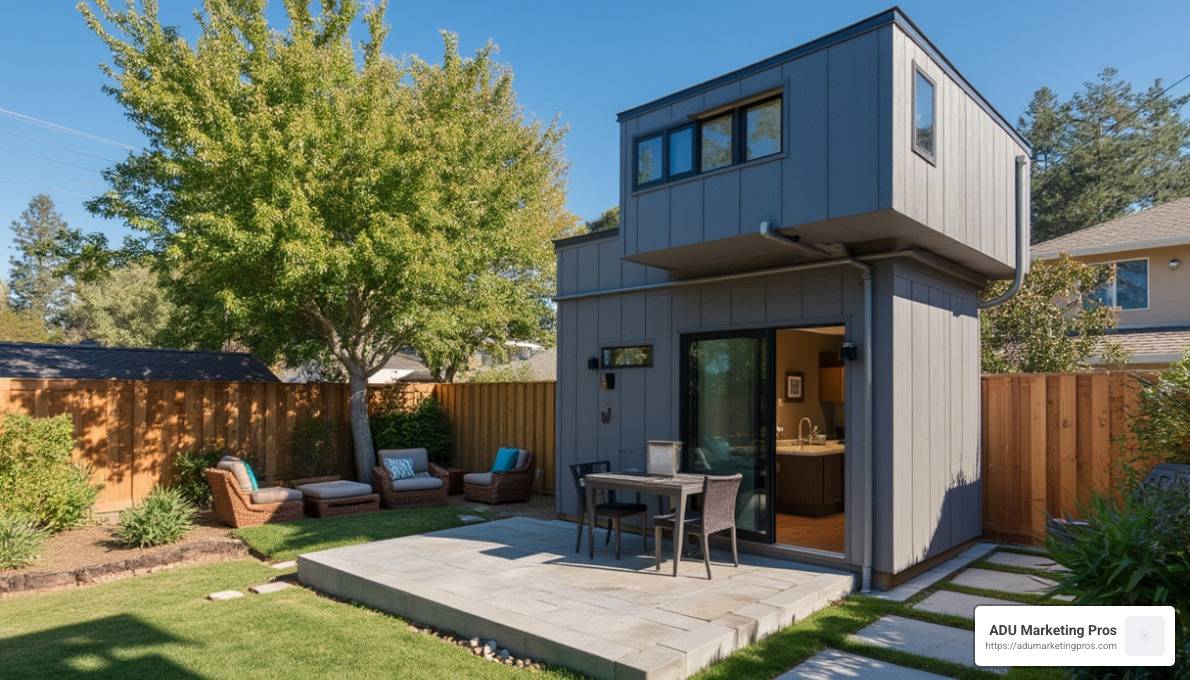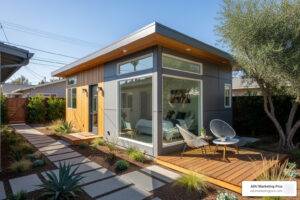ADU permits California have sparked a wave of interest amidst the state’s evolving housing landscape. The push for accessory dwelling units (ADUs) is not only changing neighborhoods but also offering solutions to some of California’s most pressing housing issues.
Here’s what you need to know about ADU permits California:
- Purpose: ADUs, also known as granny flats or in-law units, provide additional living space, which can be rented or used by family members.
- Process: Homeowners need to steer local zoning laws and permit requirements to build an ADU.
- Benefits: ADUs can increase property value, offer rental income, and add housing flexibility.
- Incentives: Programs like the CalHFA ADU Grant offer financial support for ADU projects.
California’s drive to expand ADU development is reshaping communities by enabling homeowners to create new living spaces efficiently and legally. The flexibility to build ADUs on existing properties improves housing options, contributing to the state’s efforts to tackle housing shortages. Additionally, new laws and financial incentives are making it easier for homeowners to start on these projects.
With the potential to boost income through long-term rentals, increase property values, and even help alleviate homelessness, ADUs are a viable option for many Californians. This shift is supported by regulations that simplify the approval process, granting more freedom to property owners while maintaining essential community guidelines.

Understanding ADU Permits in California
Navigating the ADU permits California landscape can seem daunting, but with a clear understanding of the key requirements, it becomes manageable. Here’s a breakdown of what you need to know:
Key Permit Requirements
-
Zoning Rules: Every city has its own zoning regulations that determine where ADUs can be built. These rules dictate the size, height, and location of the unit on the property. Recent changes have relaxed height restrictions, allowing ADUs to be up to 25 feet tall in some areas.
-
Sanitation and Water Supply: ADUs must have adequate sanitation and water supply systems. This typically means connecting to the existing sewer and water lines of the main house. In some cases, separate systems might be required depending on local regulations.
-
Building Permits: To ensure safety and compliance, a building permit is necessary. This includes meeting state and local building codes, which cover everything from structural integrity to fire safety.
ADU Permit Costs
The cost of obtaining an ADU permit varies widely across California. Here’s a quick overview of what to expect:
-
Permit Fees: These can range from a few hundred to several thousand dollars, depending on the city. For example, cities like Los Angeles might have different fee structures compared to smaller towns.
-
City Fees: Additional costs might include impact fees, which are charges to cover the potential impact on local infrastructure. Some cities have reduced or waived these fees to encourage ADU construction.
-
Cost Variations: Factors like the size of the ADU, whether it’s attached or detached, and the complexity of the project can all influence the final cost. It’s crucial to consult with local planning departments to get an accurate estimate.

Understanding these requirements and costs is essential for anyone considering building an ADU in California. With the right information and preparation, the process can be smooth and rewarding, providing additional living space and potential rental income.
Recent Changes in ADU Laws
The landscape of ADU permits in California has seen significant changes in recent years, with new legislation making it easier for homeowners to build and use these units. Let’s explore the key legislative updates and their implications.
Impact of New Legislation
Senate Bill 897 has been a game changer, especially concerning height restrictions. Previously, ADUs were capped at 16 feet, but now they can reach up to 25 feet in some areas. This change allows for more versatile designs and better use of vertical space, which is crucial in urban areas where land is limited.
Another critical update comes from Assembly Bill 2533. This bill focuses on unpermitted structures, providing a pathway to legalize ADUs built before 2020. The law requires local agencies to permit these structures unless they pose a health or safety risk. This move is expected to bring many unpermitted ADUs into compliance, enhancing property values and increasing housing availability.
Senate Bill 1211 tackles setback redefinitions. Under the new rules, if an 800 square foot ADU encroaches on the front setback, it can no longer be a reason for application denial. This change simplifies the approval process and encourages more ADU construction.
Future ADU Law Developments
Looking ahead, several laws set to take effect in 2025 will further shape the ADU landscape. Assembly Bill 434 and Senate Bill 1077 are at the forefront of these changes.
Assembly Bill 434 aims to streamline the permitting process even further, ensuring that local ordinances align with state laws. This bill will reduce the power of local agencies to impose stricter regulations than those set by the state, promoting consistency and fairness across California.
Senate Bill 1077 focuses on the Coastal Zone, a region notorious for its complex regulations. By July 2026, the Coastal Commission and the Department of Housing and Community Development will provide clear guidance to simplify ADU permitting in these areas. This initiative is expected to open up more opportunities for coastal development, addressing housing shortages in high-demand regions.
These legislative updates reflect California’s commitment to expanding housing options and addressing the state’s housing crisis. By understanding and leveraging these changes, homeowners and developers can take advantage of new opportunities in the ADU market.
Financial Assistance and Grants
Available Grants and Programs
Building an ADU can be a significant investment, but California offers several financial assistance programs to ease the burden. Understanding these options can make a big difference in your project.
CalHFA ADU Grant Program
The CalHFA ADU Grant Program is a notable initiative. It provides up to $40,000 for homeowners to cover pre-development costs like site preparation, architectural designs, and permits. However, it’s important to note that this grant is currently paused in 2024, with expectations for it to resume soon.
State Funding Laws and Financial Incentives
California’s Health and Safety Code Section 65583(c)(7) emphasizes promoting ADUs for affordable housing. This has led to various state-funded programs:
-
CalHome Program: Offers funds for first-time homebuyer assistance, rehabilitation of ADUs, and construction loans.
-
Local Early Action Planning (LEAP) Grants: These grants support local jurisdictions in ADU planning and ordinance development, ensuring compliance with state regulations.
-
Regional Early Action Planning (REAP) Grants: Aimed at regional entities, these grants help establish Prohousing Policies, including adopting ADU ordinances to reduce barriers for homeowners.
Community Development Block Grant Program (CDBG)
This federal program allocates funds for community development, including ADU rehabilitation and planning. Eligibility is based on income qualifications and local jurisdiction partnerships.
Local Programs
Various local programs further support ADU development:
-
City of San Jose and City of Chico provide pre-approved ADU plans to streamline the construction process.
-
San Diego Housing Commission ADU Finance Program offers construction loans up to $200,000, along with technical assistance.
These grants and programs demonstrate California’s commitment to expanding affordable housing through ADUs. By tapping into these resources, homeowners can significantly reduce the financial barriers to building an ADU.
Frequently Asked Questions about ADU Permits California
Do you need a permit for ADU in California?
Yes, you definitely need a permit for an ADU in California. The state has specific requirements to ensure safety, zoning compliance, and environmental considerations. Local ordinances play a crucial role in the permit process. Each city or county may have its own set of rules, so check with your local planning department to understand what’s required in your area.
The permitting process can include multiple steps, such as obtaining building permits, ensuring zoning compliance, and meeting sanitation and water supply requirements. Since these rules can vary widely, it’s a good idea to consult with local authorities or a professional who is familiar with your area’s regulations.
How much does an ADU permit cost in California?
The cost for an ADU permit in California can vary significantly depending on several factors, including location, size, and type of ADU. Homeowners should expect to pay anywhere between $2,000 and $10,000 for permits, inspections, and other regulatory requirements.
For example, urban areas like Los Angeles might have higher fees than smaller towns due to the complexity of zoning laws and the demand for housing. Additionally, the type of ADU—whether it’s attached, detached, or a conversion—can also affect the permit cost. It’s crucial to factor in these costs when planning your budget for an ADU project.
What is the $40,000 grant in California for ADUs?
The $40,000 grant in California is part of the CalHFA ADU Grant Program. This initiative aims to help homeowners cover pre-development expenses, such as site preparation, architectural designs, and impact fees. However, it’s important to note that the grant is not currently available in 2024 but is expected to resume soon.
This grant is a significant financial aid for those looking to build an ADU, as it can alleviate some of the upfront costs associated with the project. Homeowners interested in this grant should keep an eye on updates regarding its availability and eligibility criteria.

By understanding these aspects of ADU permits California, homeowners can better steer the complexities of building an ADU and take advantage of available financial assistance.
Conclusion
At ADU Marketing Pros, we’re passionate about helping ADU construction and architecture firms thrive in California’s competitive market. Our digital marketing solutions are designed to lift your business by attracting high-quality leads and enhancing your online presence.
The ADU sector is experiencing significant growth, driven by recent legislative changes that make constructing Accessory Dwelling Units easier and more flexible. With California’s ongoing housing crisis, ADUs offer a viable solution, providing affordable housing options and additional income streams for homeowners.
Our team specializes in custom marketing strategies, utilizing targeted SEO, PPC, and social media campaigns to ensure your firm stands out. By focusing on expertise rather than price, we help you build a strong brand identity and drive measurable growth.
As the ADU landscape evolves, staying informed about legislative updates and financial incentives is crucial. Our continuous market research and data-driven insights keep you ahead of the curve, enabling you to adapt and succeed in this dynamic environment.
Ready to take your ADU business to the next level? Explore our ADU Marketing Solutions and let us help you achieve your goals. Together, we can open up the full potential of the booming ADU market in California.




